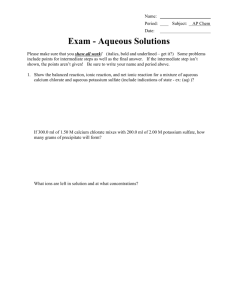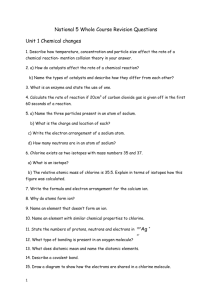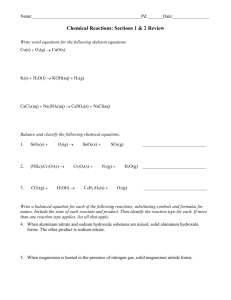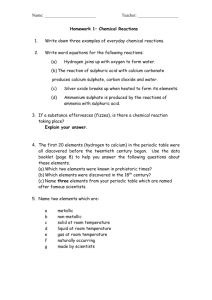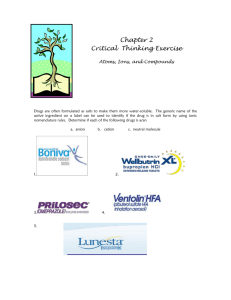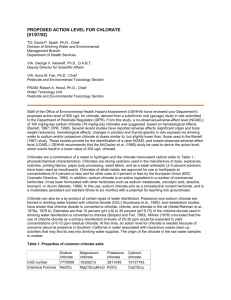obtainment of calcium-magnesium chlorate defoliant from dolomite
advertisement
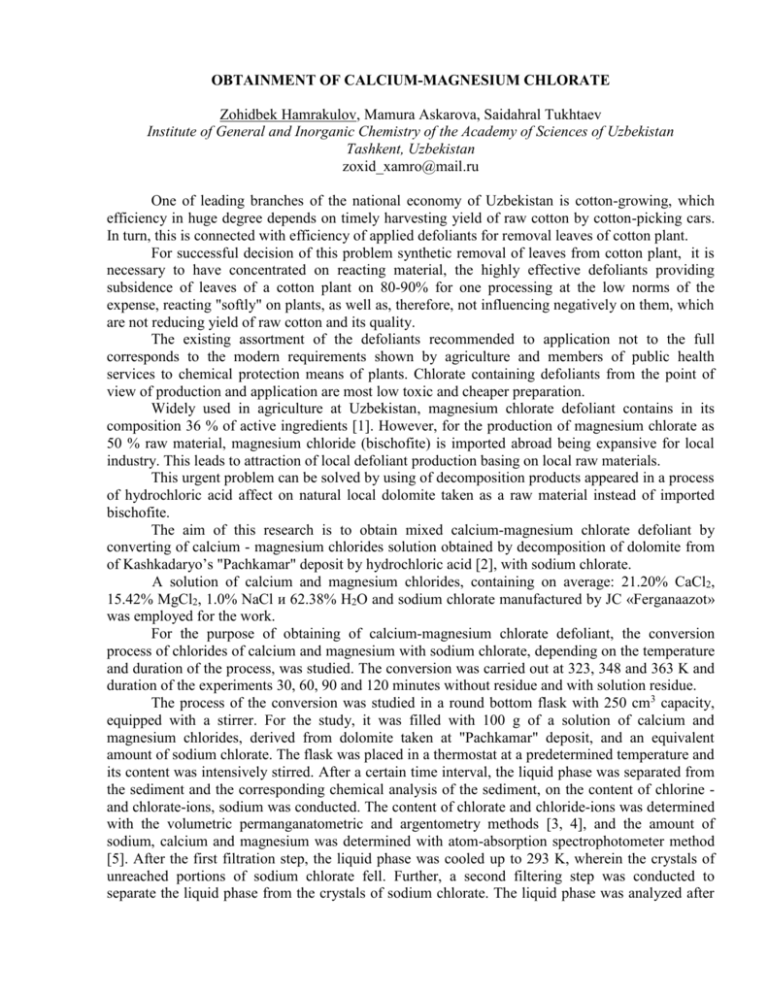
OBTAINMENT OF CALCIUM-MAGNESIUM CHLORATE Zohidbek Hamrakulov, Mamura Askarova, Saidahral Tukhtaev Institute of General and Inorganic Chemistry of the Academy of Sciences of Uzbekistan Tashkent, Uzbekistan zoxid_xamro@mail.ru One of leading branches of the national economy of Uzbekistan is cotton-growing, which efficiency in huge degree depends on timely harvesting yield of raw cotton by cotton-picking cars. In turn, this is connected with efficiency of applied defoliants for removal leaves of cotton plant. For successful decision of this problem synthetic removal of leaves from cotton plant, it is necessary to have concentrated on reacting material, the highly effective defoliants providing subsidence of leaves of a cotton plant on 80-90% for one processing at the low norms of the expense, reacting "softly" on plants, as well as, therefore, not influencing negatively on them, which are not reducing yield of raw cotton and its quality. The existing assortment of the defoliants recommended to application not to the full corresponds to the modern requirements shown by agriculture and members of public health services to chemical protection means of plants. Chlorate containing defoliants from the point of view of production and application are most low toxic and cheaper preparation. Widely used in agriculture at Uzbekistan, magnesium chlorate defoliant contains in its composition 36 % of active ingredients [1]. However, for the production of magnesium chlorate as 50 % raw material, magnesium chloride (bischofite) is imported abroad being expansive for local industry. This leads to attraction of local defoliant production basing on local raw materials. This urgent problem can be solved by using of decomposition products appeared in a process of hydrochloric acid affect on natural local dolomite taken as a raw material instead of imported bischofite. The aim of this research is to obtain mixed calcium-magnesium chlorate defoliant by converting of calcium - magnesium chlorides solution obtained by decomposition of dolomite from of Kashkadaryo’s "Pachkamar" deposit by hydrochloric acid [2], with sodium chlorate. A solution of calcium and magnesium chlorides, containing on average: 21.20% СaCl2, 15.42% MgCl2, 1.0% NaCl и 62.38% H2O and sodium chlorate manufactured by JC «Ferganaazot» was employed for the work. For the purpose of obtaining of calcium-magnesium chlorate defoliant, the conversion process of chlorides of calcium and magnesium with sodium chlorate, depending on the temperature and duration of the process, was studied. The conversion was carried out at 323, 348 and 363 K and duration of the experiments 30, 60, 90 and 120 minutes without residue and with solution residue. The process of the conversion was studied in a round bottom flask with 250 cm3 capacity, equipped with a stirrer. For the study, it was filled with 100 g of a solution of calcium and magnesium chlorides, derived from dolomite taken at "Pachkamar" deposit, and an equivalent amount of sodium chlorate. The flask was placed in a thermostat at a predetermined temperature and its content was intensively stirred. After a certain time interval, the liquid phase was separated from the sediment and the corresponding chemical analysis of the sediment, on the content of chlorine and chlorate-ions, sodium was conducted. The content of chlorate and chloride-ions was determined with the volumetric permanganatometric and argentometry methods [3, 4], and the amount of sodium, calcium and magnesium was determined with atom-absorption spectrophotometer method [5]. After the first filtration step, the liquid phase was cooled up to 293 K, wherein the crystals of unreached portions of sodium chlorate fell. Further, a second filtering step was conducted to separate the liquid phase from the crystals of sodium chlorate. The liquid phase was analyzed after the second filtration for the content of ClO3-, Cl-, Ca+2, Mg+2 and Na+ ions examination (table. 1). Table 1 Dependence of the degree of calcium and magnesium chlorides interaction with sodium chlorate on the temperature and duration of the process during the conversion without residue and with residue Σ Calcium and The activation TempeTime magnesium chlorate Degree of 1/Т·10-3 energy, (Еа·103) rature, К (τ), min. content in the liquid conversion Ск, % kJ/mol) phase, % for conversion without residue 30 3,75 9,73 323 3,10 60 7,01 18,20 90 10,63 27,59 120 12,07 31,31 30 5,68 14,74 22,338 348 2,90 60 11,37 29,50 90 15,44 40,07 120 17,14 44,47 30 7,95 20,64 363 2,75 60 15,82 41,05 90 20,92 54,27 120 22,14 57,44 for conversion with residue 30 6,26 11,79 323 3,10 60 12,58 23,70 90 18,17 34,24 120 19,66 37,06 30 11,95 22,52 348 2,90 60 23,70 44,67 29,392 90 31,17 58,75 120 34,29 64,63 30 18,48 34,82 363 2,75 60 31,07 58,56 90 39,59 74,62 120 41,62 78,44 lg(Co- Cτ) (average) 1,478 1,412 1,327 1,586 1,424 1,267 The experimental data at table 1 indicate that the degree of formation of calcium and magnesium chlorate from calcium and magnesium chlorides during the process without solution residue after 60 minutes at 323, 348 and 363 K are respectively 18.20, 29.50 and 41.05%, and after 90 minutes, respectively, 27.59, 40.07 and 54.27%. By increasing the duration of the conversion process up to 120 minutes, the increase of the degree of conversion varies slightly and at temperature mentioned above the degrees of conversion were 31.31, 44.47 and 57.44% respectively. The amounts of calcium and magnesium chlorates in the solution after conversion under the above mentioned temperatures and process duration of 60, 90 and 120 minutes were respectively 7.01, 11.37, 15.82%; 10.63, 15.44, 20.92% and 12.07, 17.14, 22.14%. Studies of conversion of calcium and magnesium chlorides with sodium chlorate conducted without the solution residue showed that the maximum degree of conversion at 363 K for 120 minutes achieved only 57.44%, which is not high enough. To increase the degree of conversion, studies of calcium and magnesium chlorides conversion with sodium chlorate carried at solution residue were fulfilled. In carrying out the conversion with the residue, the intensity of the process considerably accelerates, as demonstrated by the data in table 1. Thus, at 323 K after 60, 90 and 120 minutes the degree of conversion increases by 1.30, 1.24 and 1.18 times. As a result of an increase in the temperature, the conversion process accelerates and the degree of the water removal increases. After the duration of the process of 60, 90 and 120 minutes at 348 K, the degree of conversion is increased by 1.51, 1.47 and 1.45 times, and at 363 K after 60, 90 and 120 minutes the degree of conversion reaches a maximum value, i.e. is increased by 1.43, 1.37 and 1.37 times. At a temperature of 363 K during 120 minutes, maximum degree of conversion of 78.44% is achieved. Conversion product contains: 40.2% Σ calcium and magnesium chlorate; 7.3% Σ calcium and magnesium chloride; 1.2% sodium chloride, and the remaining being water. For the conversion process, the order of reaction on kinetic equation (1) was determined [6]: Cо 2.303 К lg (1) (Cо С ) with Со и Сτ respectively being concentration of calcium and magnesium chlorides in the initial stage of the conversion and for the past time interval (τ); K - constant of the conversion speed. According to the data achieved, the order of the process of calcium and magnesium chlorides conversion with sodium chlorate is of the first order. Evidence of this is that the constant of the conversion velocity, calculated using equation (1) based on experimental data, remains practically constant for each temperature within the first 120 minutes (table 2). Table 2 The constant of the velocity of interaction of calcium and magnesium chlorides with sodium chlorate in the conversion without residue and with residue Time (), minute 30 60 90 120 average 30 60 90 120 average Constant of the speed, (К10-2, -1) 323 К 348 К 363 К for conversion without residue 0,3409111 0,5309668 0,7693188 0,3342713 0,5820206 0,8797074 0,3581943 0,5680704 0,8684139 0,3127329 0,4896512 0,7109752 0,3365274 0,5426772 0,8071038 for conversion with residue 0,4185425 0,8507264 1,4274167 0,4511068 0,9864946 1,4683237 0,4658873 0,9839477 1,5235614 0,3857923 0,8661255 1,2788198 0,4303322 0,9218235 1,4245304 In addition, the rectilinear dependence of lg (Co-Сτ) on τ attests the first reaction’s order of the process of the conversion of calcium and magnesium chlorides with sodium chlorate (table 1). The reaction velocity’s constant increases with temperature increasing (see table 1 and 2) and its change depending on temperature is a subject to the Arrhenius law that is confirmed with the rectilinear graph dependence nature of lg K on 1/T (fig. 1). Fig. 1. Dependence of lg K on 1/T in the conversion without residue (a) and with residue (b). To set the value of the constant of the conversion velocity for different temperatures, a preexponential factor, ie empirical constant (Ко) was calculated in the Arrhenius equation E RT K Kо e (2) and the dependence equation of lgK on 1 / T was inferred. On the basis of obtained data the constants of reaction rate of conversion for various temperatures in the range 323-363 K, within every 10 K, as well as the temperature coefficient of the conversion velocity are calculated (see table 3). Table 3 The reaction velocity constant and the temperature coefficient of conversion at different temperatures Temperature, К 323 333 343 353 363 323 333 343 353 363 Constant of the conversion The temperature coefficient of velocity, Кּ10-2 min-1 conversion velocity (γ) for conversion without residue 0,337 0,454 1,347 0,572 1,260 0,689 1,205 0,807 1,171 for conversion with residue 0,430 0,679 1,579 0,927 1,365 1,176 1,269 1,425 1,212 According to the obtained data, the temperature coefficient of conversion velocity increases 1.171 – 1.347 times when temperature is increased by 10 K step in a range of 323-363 K during the conversion without residue, and during the conversion with residue it increases 1.212-1.579 times. The optimal parameters of mixed calcium and magnesium chlorate obtaining is the following the conversion of chlorides of calcium and magnesium with sodium chlorate at their molar ratio accordingly 1:2, during 120 minutes at 363 K temperature with the solution residue. References 1. Liquid magnesium chlorate defoliant. Specifications. TSh 88.16-34. - 2010. Tashkent city: Uzbekistan standard agency’s publishing house - 10 p. 2. Hamrakulov Z.A, Askarova M.K, Tukhtaev S. Obtaining of solution of calcium magnesium chloride from dolomite / / Journal of Chemical Industry. – Moscow (Russia), 2013. - Nr 2. p. 70-78. 3. State standard 12257-77. Sodium chlorate. Specifications. Moscow city: Standard agency’s publishing house, 1987. – p. 19. 4. E.N. Dorokhova, G.V. Prokhorova. Analytical chemistry. Physical-chemical methods of analysis. M.: Visshaya shkola, 1991. 5. Khavezov I., Salev D. Atom-absorption analysis: Trans. By G.A. Sheynina form Bulgarian. Editor. S.Z. Yakovleva. – L.: Chemistry, 1983. – p. 144. with figures – Sophia, 1980. 6. Ospanov J.C. Physico-chemical basis of selective dissolution of minerals. – Moscow city (Russia): “Nedra” publishing house. 1993. – p. 175.


